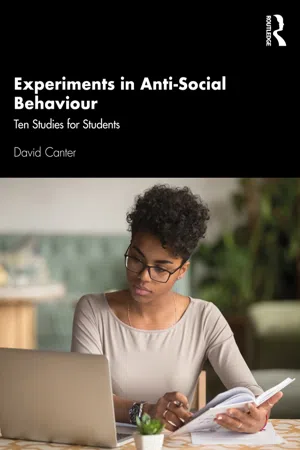
- 280 pages
- English
- ePUB (mobile friendly)
- Available on iOS & Android
About This Book
For a practical, hands-on approach to learning forensic psychology, Experiments in Anti-Social Behaviour: Ten Studies for Students presents a collection of unique projects for students that illustrate the many ways research into anti-social behaviour can be conducted whilst also highlighting social psychological aspects of criminality.
Drawing on over half a century of supervising many hundreds of projects at high school, undergraduate, master's, and doctoral levels, David Canter provides well-grounded and detailed guidance for students on how to execute a range of different research studies through several psychological approaches, including quantitative cognitive studies, qualitative discourse analysis, and social identity theory. After introducing the ethical and practical challenges of studying crime and criminality, Experiments in Anti-Social Behaviour outlines broad approaches to research. This is followed by ten practical studies for students to carry out in order to engage directly with experimental research. These studies cover experiments, surveys, and case studies, and include a controlled examination of how easy it is to forge a signature, descriptions of experiments trying to detect deception, and an exploration of what is involved in linking actions in a serial killer's crimes to his characteristics.
Both engaging and interactive, Experiments in Anti-Social Behaviour is an invaluable resource for instructors and students from colleges and universities around the world in many different fields, such as psychology, criminology, and socio-legal studies. It will also be of interest to all those who want to know more about the psychology of crime and criminality.
Frequently asked questions
Information
PART ONE
Challenges and concerns when studying anti-social activity
Synopsis
Some Key Concepts
Ethical, Professional, and Legal Concerns
Ethical issues
Do no harm
Proportionality
Worthwhile
Privacy and confidentiality
Informed consent
Table of contents
- Cover
- Half Title
- Title Page
- Copyright Page
- Dedication
- Table of Contents
- List of Figures
- List of Tables
- Preface
- Part One Challenges and concerns when studying anti-social activity
- Part Two Approaches to research
- Part Three Ten studies
- Appendix A: Guidelines for ethics in psychological research
- Appendix B: A very brief introduction to smallest space analysis (SSA)
- Index